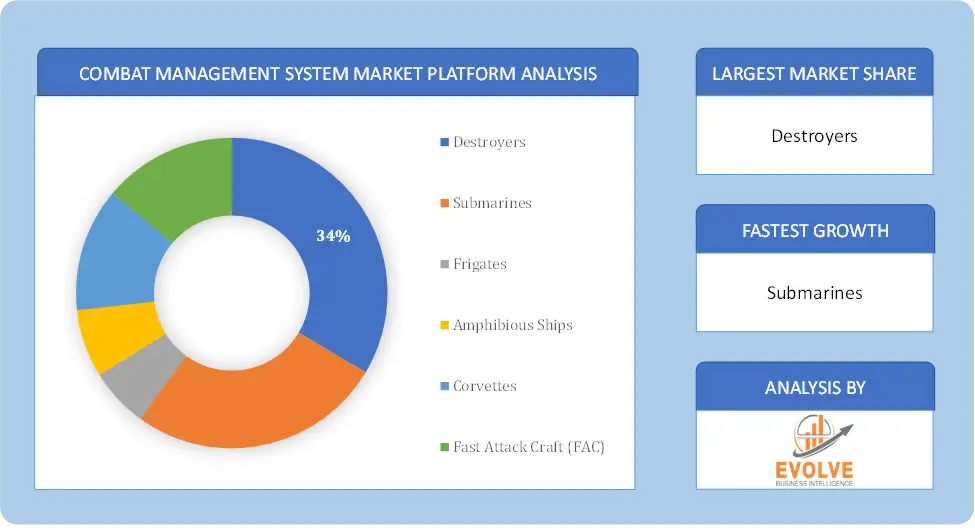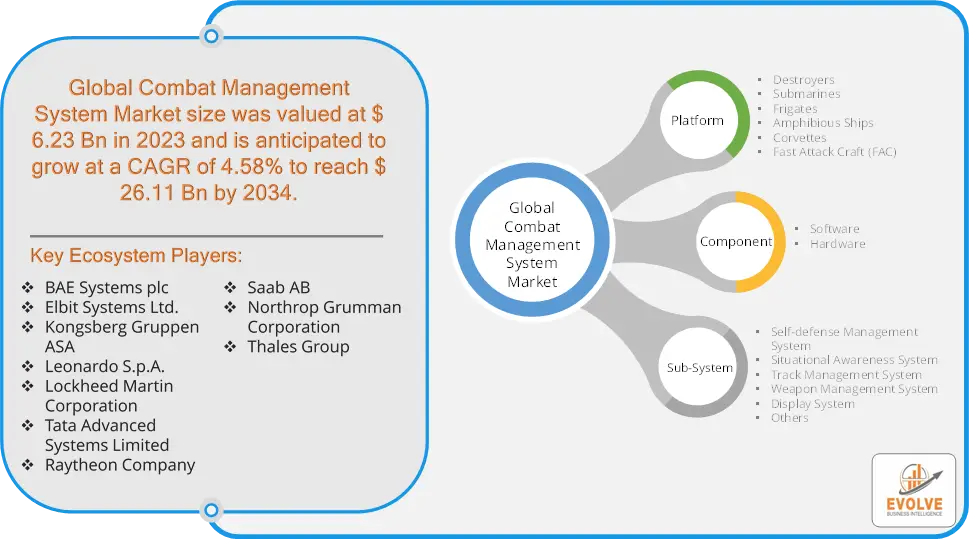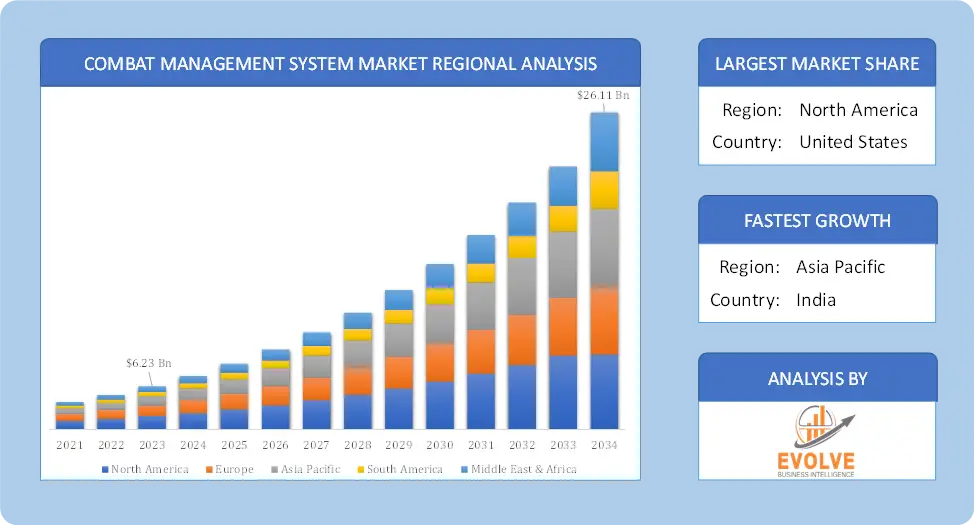Combat Management System Market Overview
The Combat Management System Market Size is expected to reach USD 26.11 Billion by 2033. The Combat Management System Market industry size accounted for USD 6.23 Billion in 2023 and is expected to expand at a compound annual growth rate (CAGR) of 4.58% from 2023 to 2033. A combat management system (CMS) is a complex software-based system that integrates all onboard systems of naval vessels and submarines. It acts as the central nervous system of a warship, providing situational awareness, intelligence, planning, decision-making, and command and control of weapon systems.
The combat management system market is expected to continue growing due to technological advancements, increasing maritime threats, and the modernization of naval fleets.
Global Combat Management System Market Synopsis
 Combat Management System Market Dynamics
Combat Management System Market Dynamics
The major factors that have impacted the growth of Combat Management System Market are as follows:
Drivers:
Ø Technological Advancements
Ongoing innovations in technologies such as artificial intelligence (AI), big data analytics, sensor integration, and cybersecurity are significantly improving the capabilities of combat management systems. These advancements enable more efficient data processing, real-time decision-making, and better integration of various subsystems. With the increasing digitalization of defense systems, cybersecurity has become a critical concern. Combat management systems are being enhanced with robust cybersecurity measures to protect against cyber threats and ensure the integrity and reliability of defense operations.
Restraint:
- Perception of High Costs of Development and Implementation and Cybersecurity Risks
Developing and deploying advanced combat management systems involves significant costs, including research and development, hardware, software, integration, and maintenance. These high costs can be a barrier for countries with limited defense budgets, slowing down the adoption of CMS technologies. As combat management systems become more reliant on digital technologies and networked operations, they are increasingly vulnerable to cyberattacks. Ensuring the cybersecurity of these systems is a major concern, and any breaches could compromise the effectiveness of the CMS and lead to significant operational risks.
Opportunity:
⮚ Rising Demand for Next-Generation Naval Platforms
The development and deployment of next-generation naval platforms, such as advanced destroyers, frigates, and submarines, offer significant opportunities for the CMS market. These platforms require cutting-edge combat management systems to fully leverage their capabilities, creating demand for new and upgraded CMS technologies. Integrating artificial intelligence (AI) and machine learning (ML) into combat management systems can enhance decision-making, automate threat detection, and optimize resource allocation. These technologies offer opportunities to develop more intelligent and responsive CMS solutions, which are increasingly sought after by military forces.
Combat Management System Market Segment Overview
By Platform
 Based on Platform, the market is segmented based on Destroyers, Submarines, Frigates, Amphibious Ships, Corvettes and Fast Attack Craft (FAC). The Corvettes segment dominant the market. Corvettes play a crucial role in naval fleets, especially for nations with extensive coastlines or those involved in littoral (nearshore) combat. They are designed to operate in various environments and perform multiple missions, including anti-surface warfare (ASuW), anti-submarine warfare (ASW), and air defense.
Based on Platform, the market is segmented based on Destroyers, Submarines, Frigates, Amphibious Ships, Corvettes and Fast Attack Craft (FAC). The Corvettes segment dominant the market. Corvettes play a crucial role in naval fleets, especially for nations with extensive coastlines or those involved in littoral (nearshore) combat. They are designed to operate in various environments and perform multiple missions, including anti-surface warfare (ASuW), anti-submarine warfare (ASW), and air defense.
By Component
Based on Component, the market has been divided into Software and Hardware. The software segment dominated the market. The growth of the segment can be attributed to the high development cost of software, which is based on the intricate architecture of the combat management system.
By Sub-System
Based on Sub-System, the market has been divided into Self-defense Management System, Situational Awareness System, Track Management System, Weapon Management System, Display System and Others. The Track Management System segment dominant the market. The Track Management System (TMS) is responsible for detecting, tracking, and classifying various objects, such as enemy vessels, aircraft, missiles, and submarines. It consolidates data from multiple sensors, including radar, sonar, and electro-optical devices, to create a coherent and real-time picture of the operational environment.
Global Combat Management System Market Regional Analysis
Based on region, the global Combat Management System Market has been divided into North America, Europe, Asia-Pacific, the Middle East & Africa, and Latin America. North America is projected to dominate the use of the Combat Management System Market followed by the Asia-Pacific and Europe regions.
 Combat Management System North America Market
Combat Management System North America Market
North America holds a dominant position in the Combat Management System Market. The U.S. has a significant demand for CMS systems. The country has invested heavily in modernizing its fleet and developing advanced CMS technologies. The U.S. is the largest defense spender globally, with significant investments in naval modernization and advanced combat management systems and strong focus on integrating AI and cybersecurity features into CMS.
Combat Management System Asia-Pacific Market
The Asia-Pacific region has indeed emerged as the fastest-growing market for the Combat Management System Market industry. As a rapidly growing economic and military power, China has been investing heavily in modernizing its navy. This has led to a significant demand for CMS systems and India has a large and growing navy, and has been investing in modernizing its fleet. This has created a demand for CMS systems.
Competitive Landscape
The global Combat Management System Market is highly competitive, with numerous players offering a wide range of software solutions. The competitive landscape is characterized by the presence of established companies, as well as emerging startups and niche players. To increase their market position and attract a wide consumer base, the businesses are employing various strategies, such as product launches, and strategic alliances.
Prominent Players:
- BAE Systems plc
- Elbit Systems Ltd.
- Kongsberg Gruppen ASA
- Leonardo S.p.A.
- Lockheed Martin Corporation
- Tata Advanced Systems Limited
- Raytheon Company
- Saab AB
- Northrop Grumman Corporation
- Thales Group
Key Development
In March 2024, Tawazun Council, Naval Group, and Marakeb Technologies have signed a Joint Development Agreement to build the National Combat Management System (NCMS) through a comprehensive transfer of technology and know-how. Naval Group has signed an agreement with Marakeb Technologies LLC, a subsidiary of Strategic Development Fund Company, to collaborate on a joint development national program in Abu Dhabi.
Scope of the Report
Global Combat Management System Market, by Platform
- Destroyers
- Submarines
- Frigates
- Amphibious Ships
- Corvettes
- Fast Attack Craft (FAC)
Global Combat Management System Market, by Component
- Software
- Hardware
Global Combat Management System Market, by Sub-System
- Self-defense Management System
- Situational Awareness System
- Track Management System
- Weapon Management System
- Display System
Global Combat Management System Market, by Region
- North America
- US
- Canada
- Mexico
- Europe
- UK
- Germany
- France
- Italy
- Spain
- Benelux
- Nordic
- Rest of Europe
- Asia Pacific
- China
- Japan
- South Korea
- Indonesia
- Austalia
- Malaysia
- India
- Rest of Asia Pacific
- South America
- Brazil
- Argentina
- Rest of South America
- Middle East & Africa
- Saudi Arabia
- UAE
- Egypt
- South Africa
- Rest of Middle East & Africa
| Parameters | Indicators |
|---|---|
| Market Size | 2033: $26.11 Billion |
| CAGR | 4.58% CAGR (2023-2033) |
| Base year | 2022 |
| Forecast Period | 2023-2033 |
| Historical Data | 2021 |
| Report Coverage | Revenue Forecast, Competitive Landscape, Growth Factors, and Trends |
| Key Segmentations | Platform, Component, Sub-System |
| Geographies Covered | North America, Europe, Asia-Pacific, Latin America, Middle East, Africa |
| Key Vendors | BAE Systems plc, Elbit Systems Ltd., Kongsberg Gruppen ASA, Leonardo S.p.A., Lockheed Martin Corporation, Tata Advanced Systems Limited, Raytheon Company, Saab AB, Northrop Grumman Corporation and Thales Group |
| Key Market Opportunities | • Rising Demand for Next-Generation Naval Platforms • Adoption of Artificial Intelligence and Machine Learning |
| Key Market Drivers | • Technological Advancements • Cybersecurity Concerns |
REPORT CONTENT BRIEF:
- High-level analysis of the current and future Combat Management System Market trends and opportunities
- Detailed analysis of current market drivers, restraining factors, and opportunities in the future
- Combat Management System Market historical market size for the year 2021, and forecast from 2023 to 2033
- Combat Management System Market share analysis at each product level
- Competitor analysis with detailed insight into its product segment, Government & Defense strength, and strategies adopted.
- Identifies key strategies adopted including product launches and developments, mergers and acquisitions, joint ventures, collaborations, and partnerships as well as funding taken and investment done, among others.
- To identify and understand the various factors involved in the global Combat Management System Market affected by the pandemic
- To provide a detailed insight into the major companies operating in the market. The profiling will include the Government & Defense health of the company’s past 2-3 years with segmental and regional revenue breakup, product offering, recent developments, SWOT analysis, and key strategies.







